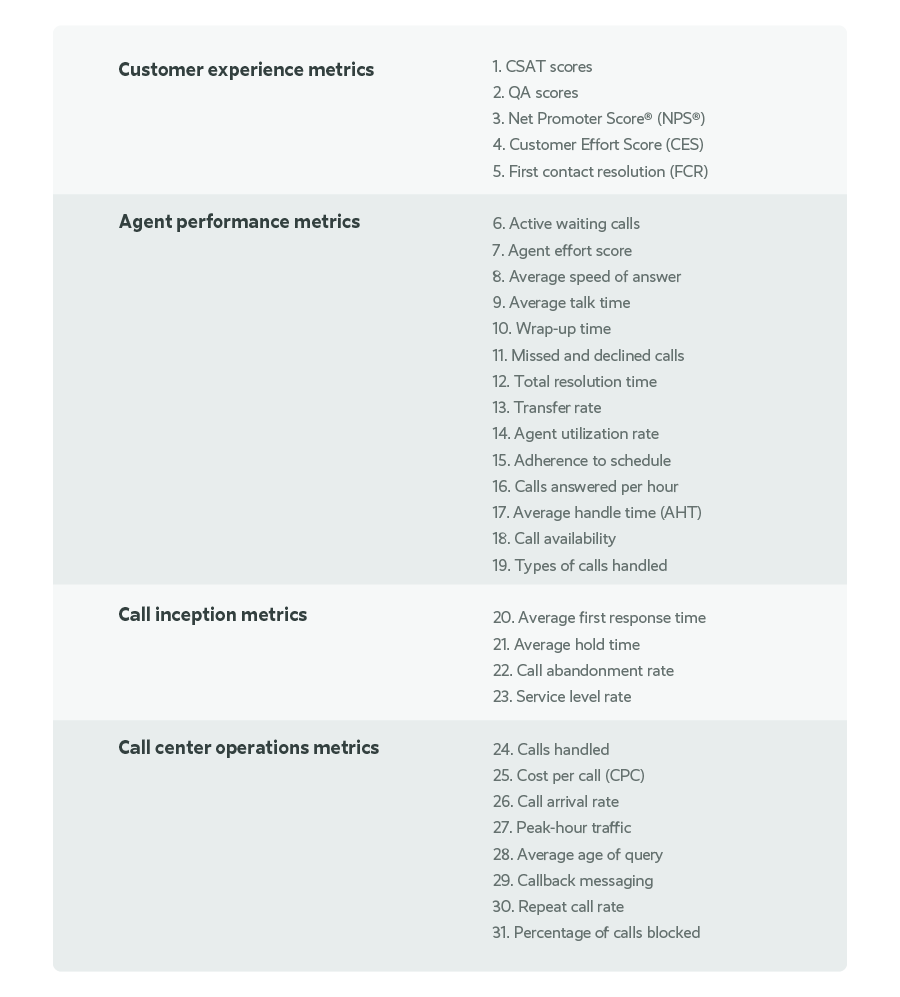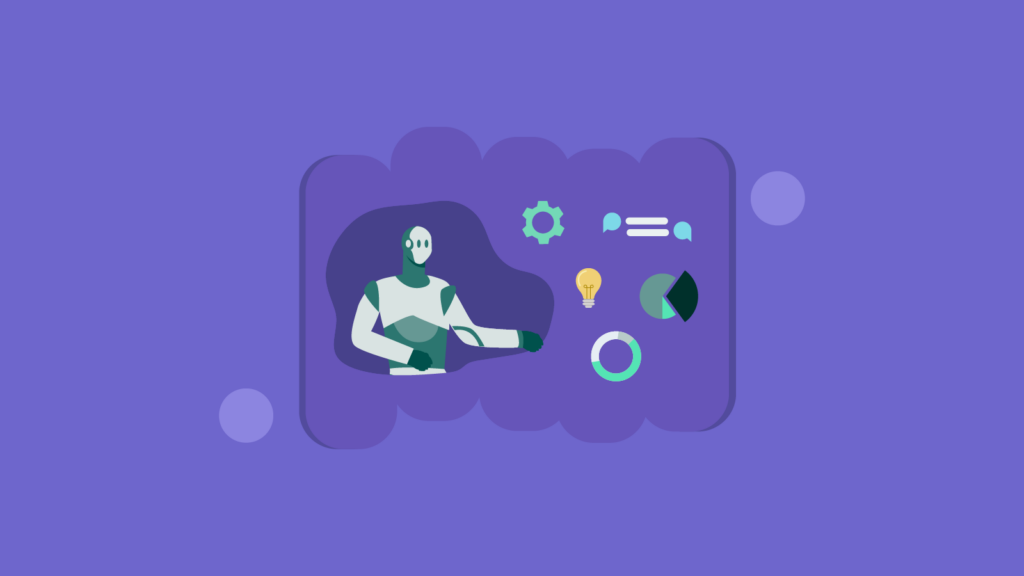Top Call Center Efficiency Metrics And How To Improve Them
Tracking, reporting, and improving upon metrics are essential across all areas of business, including finance, sales, marketing, and contact center management. In uncertain economic times, they become even more critical to help navigate business health and growth.
Call center leaders are under increased pressure to improve operational and agent efficiencies and look for cost-cutting opportunities while delivering outstanding customer experience (CX) — a tricky balancing act for sure. Understanding the key call center efficiency metrics to track, and more importantly, how to improve them, will set you up for success and help keep your customers happy.

What Are Call Center Efficiency Metrics?
Call center efficiency metrics are the collection of data used to measure and gauge the effectiveness and efficiency of call centers and contact center agents. These metrics or key performance indicators (KPIs) are put in place to help leaders benchmark and track improvements to agent performance, call center operations, and ultimately how these metrics lead to improved customer service delivery and outstanding customer experience.
KPIs or call center metrics vary from organization to organization, and different areas of the business require their own sets of KPIs or measurements. As a rule of thumb, a CFO is most interested in the financial metrics of call centers—agent efficiencies, cost savings, call center technology investment ROI, etc. Call center managers need metrics to successfully measure agent performance and improvements to call center operations.
Related Content: Your Contact Center Metrics are Outdated (Here’s What You Should Measure Instead)
Why Do Metrics Matter?
Making meaningful business decisions from the plethora of data available to companies can be daunting. Why do metrics matter? Ultimately delivering outstanding customer experiences should be a strategic business priority for organizations if it isn’t already.
McKinsey’s 2022 State of Customer Care Survey has found that customer care is now a strategic focus for companies: “Respondents say their top three priorities over the next 12 to 24 months will be retaining and developing the best people, driving a simplified customer experience (CX) while reducing call volumes and costs, and building their digital care and advanced analytics ecosystems.”
For customer support leaders, metrics tied to the goal of delivering and improving upon outstanding customer care and experiences should matter the most and be top priorities. Do your metrics provide answers to these questions?
- Are your customers happy? How do you know? How are you tracking customer satisfaction and customer experiences?
- Do you have the right technology in place to measure and support optimal CX, a hybrid workforce, and omnichannel support?
- What trends, such as AI, will shape CX in the coming years? Is your call center prepared?
- What are your agents’ strengths and weaknesses and how can you improve agent performance and efficiency? How do you boost agent retention?
Setting agreed-upon metrics across different areas of the business — IT, the C-Suite, sales, operations, etc. — is a good place to start. Once these metrics or KPIs are in place, over time you will more easily find opportunities to improve upon CX and gain call center and agent efficiencies.
Related Article: Call Center Workforce Management Metrics: How To Measure And Improve Performance
Here is our comprehensive guide to the essential call center efficiency metrics. As a bonus, in each category, we’ve added three ways to improve these metrics.

Customer Experience (CX) Metrics
It’s a strategic business objective across the organization to deliver outstanding customer experience, but how do you measure CX success? These are the most common metrics to gauge customer experience performance and success.
Net Promoter Score (NPS)
Net Promoter Score, also known as NPS, is an index ranging from -100 to 100 that measures the willingness of customers to recommend a company’s products or services to others. NPS is often answered with one single question: “On a scale from one to 10, with one being unlikely and 10 being likely, how likely are you to recommend this business to a friend?”
Customer Satisfaction (CSAT)
Perhaps the most common of CX metrics, CSAT is often in the form of a customer survey on a four- or five-point scale that indicates how satisfied a customer or group of customers is with a specific product, transaction, or interaction with a company and its service level. The Customer Satisfaction score can also be applied at the company level. Organizations conduct surveys or interviews based on an agreed-upon scoring system and classify responses such as:
- Very satisfied
- Satisfied
- Not satisfied
- Very unsatisfied
Customer Effort Score (CES)
A business metric that measures how easy or difficult it was for the customer to get their issues resolved in your contact center. For example, “On a scale of 1 to 5, how easy was it to solve your problem today?” Higher CES scores mean less customer effort, better customer experience, and more customer loyalty.
First Contact Resolution (FCR)
This common call center efficiency metric indicates whether a caller’s question is answered or a problem is solved during the initial call so that no follow-up contacts are necessary.
Three Ways To Improve Customer Experience Metrics
- Encourage customers to complete customer service surveys to measure customer satisfaction levels after individual agent interactions. Make sure customers know they are anonymous and consider a real-time incentive (e.g., 10% off their next purchase) to boost response rates.
- Keep surveys short and set customer expectations ahead of time. For example, “Please answer 3 short questions about your agent and experience today.” Allow for additional customer sentiment comments in surveys and categorize them to spot trends for improvements.
- Provide adequate agent training to be able to resolve customer questions and challenges with “one stop” and more quickly and efficiently.
Related Article: How to Deliver An Outstanding Omnichannel Customer Experience
Call Initiation/Inception Metrics
In the business of delivering outstanding customer service and experience, first impressions are everything. Even before agents are involved, customers are having positive or negative experiences with a customer support center. Metrics around these first impressions are important to track.
Average First Response Time (FRT)
This metric measures the average time that a customer waits before speaking with an agent. In general, the lower your FRT, the more likely your customers will be satisfied with the experience.
Average Hold Time
The amount of time a caller spends in an agent-initiated hold status.
Average Speed Of Answer (ASA)
The average amount of time it takes agents to answer inbound customer queries once they appear in the contact center queue.
Average Time To Abandonment (ATA)
This is the average length of time in the queue that a caller waits in before they abandon their call, sometimes referred to as average patience or average call abandonment rate.
Expected Wait Time
An estimate of how long a customer will have to wait in a queue before being connected with an agent, based on incoming volume, handling time, and staffing levels.
Percentage Of Calls Blocked
By tracking this metric, call centers can learn how many customers receive a busy tone when they call. Ideally, this metric should be very low for most businesses.
Three Ways To Improve Call Initiation Metrics
- Increase the number of agents available for inbound calls during peak times to provide faster call center support to customers.
- Offer omnichannel support options such as an AI-powered chatbot and other self-service options and menu options to reduce the need for some live agent calls.
- Put in place callback options during peak time periods to reduce wait times and call abandonment rates.
Related Article: The Importance of Accurate Forecasting for Omnichannel Volume
Agent Performance Metrics
Employees are the heart and soul of call centers and customer service organizations. Whether your call center is made up of in-person, fully remote, or hybrid agents, in general, happy customer service agents and great employee experiences (EX) yield satisfied customers and great CX.
Understanding which key metrics are important when measuring team performance and individual agent performance is half of the battle. Providing and improving upon EX leads to agent retention and boosts agent productivity.
Active Waiting Calls
This call center agent performance metric shows how well agents and teams manage call volumes and provides insight into the number of interactions agents handle vs. those on hold. A high number of calls on hold causes agent stress and can lead to poor customer experience.
Agent Utilization Rate
This metric is the percentage of time that contact center agents spend in active contact handling versus in an idle or available state.
Availability Rate
This is the proportion of time an agent is actively ready to work with customers but not engaged directly with a customer, sometimes referred to as idle time or available time.
Average Handle Time (AHT)
The AHT metric is the average call duration of an entire customer contact interaction from the time the customer initiates it until that interaction is complete. For synchronous contacts, this includes hold times, transfers, and after-call work. For example, to calculate the Average Handle Time for calls, add total talk time, total hold time, and after-call work time, then divide that number by the total number of customer calls.
Average Speed Of Answer
The average amount of time or response time it takes agents to answer inbound customer interactions once they appear in the contact center queue.
Average Talk Time
The amount of time a contact center agent spends handling customer calls and resolving queries — not to be confused with Average Handle Time, which is longer in duration.
First Contact Resolution
A case in which a customer’s question is answered or a problem is solved during the initial interaction so that no follow-up contacts are necessary.
Schedule Adherence
Schedule adherence is the amount of time agents work that coincides with the time period they are scheduled to work — sometimes simply called adherence. The time considered in adherence includes on-queue time, off-queue work, and activities such as meetings and training.
Total Resolution Time
Total resolution time measures the average length of time it takes for support agents to resolve a customer issue.
Transfer Rate
The percentage of customer calls transferred or routed to another team member, department, or queue in order to be completed or resolved.
Wrap-Up Time
The time required by an agent after a conversation is ended to complete work that is directly associated with the contact just completed.
Three Ways To Improve Agent Performance Metrics
- Contact center managers should provide additional agent training. Incorporate gamification and other engagement tactics to boost retention of content.
- Develop and enhance your knowledge base and resources available to agents to help them better resolve customer questions and challenges.
- Automate and reduce the amount of non-call-support and post-call work for agents, such as logging and reporting. Investments in technology solutions, including those integrated with customer relationship management (CRM) software can help with this automation.
Call Center Operations Metrics
Call center operations metrics are critical to helping contact center leaders manage the day-to-day operations and center performance — and also understand and improve operational performance over time. Metrics such as peak times, number of calls handled, cost per call, and other KPIs help organizations manage staffing requirements, forecasting, and spotting trends.
Average Age Of Query
This call center metric measures the average length of time unresolved customer queries stay open.
Callback Messaging
It’s becoming a call center best practice to provide customers with options to receive a call back when hold times may be lengthy. Tracking the volume of customers who select callback options and when they occur helps call center managers with staffing and forecasting in addition to contributing to better customer satisfaction.
Calls Handled
This measures the number of calls handled overall or by a specific agent or IVR system over a given period of time. It provides useful insight into agent performance and overall call volumes handled.
Call Arrival Rate
This metric tracks the number of incoming calls over a designated time frame.
Cost Per Call (CPC)
A call center metric is calculated by dividing the fully loaded cost of your contact center for a given period by the number of inbound and outbound calls handled in the same period.
Cost Per Case
The average cost per support contact can include fixed costs — such as office space and technology expenses — and variable costs, such as scheduled labor and unscheduled overtime. Sometimes referred to as cost per contact.
Peak-Hour Traffic
It’s important to know when your highest volumes of calls come in to be able to adequately schedule agents and have omnichannel support readily available.
Repeat Call Rate
This KPI helps companies understand which issues weren’t resolved the first time around. Tracking repeat calls and collecting customer feedback can reveal recurring issues and help leaders find resolutions to reduce the number of repeat calls.
Schedule Efficiency
This measurement helps track how closely scheduled resources match the forecasted number of resources needed.

Three Ways To Improve Call Center Operations Metrics
- Consider utilizing a remote or hybrid agent model to improve staffing, especially during peak call volume hours.
- Invest in agent training to empower your team to successfully resolve support calls more efficiently in less time — and the first time. This also can reduce agent attrition and lower the agent turnover rate because they feel better equipped to resolve problems and have an impact on customer loyalty.
- Leverage technology to identify trends in the number of calls, peak times, holes in knowledge, and other key call center operational metrics.
Related Article: Effective Time Management Techniques for Contact Center Agents
Boost CX With The Right Call Center Efficiency Metrics
Metrics or KPIs are critical in helping to manage and improve all areas of business, including your customer contact center. The first step is to choose the call center efficiency metrics that make sense for your business.
From there, you can make improvements to optimize your call center, including boosting agent performance and agent retention. However, the most important efficiency metrics are ultimately those that show how your organization delivers outstanding customer experience and increases customer retention as strategic business priorities.
Want to learn more about key call center efficiency metrics? Download our eBook Overlooked KPIs That Make a Difference in Your Contact Center and schedule a demo of Playvox’s robust workforce management solution.






